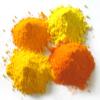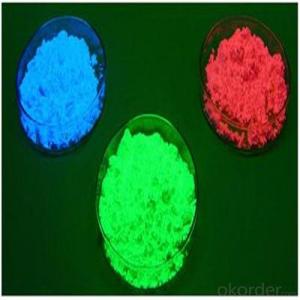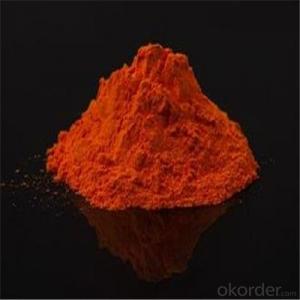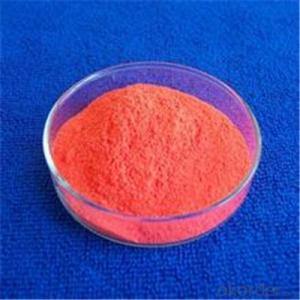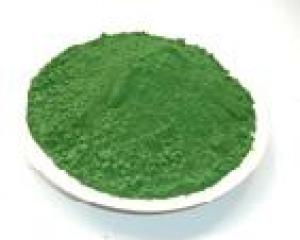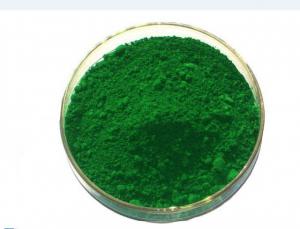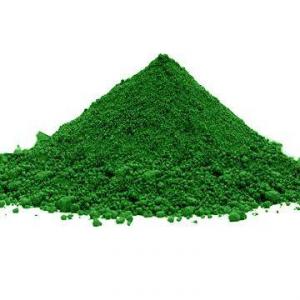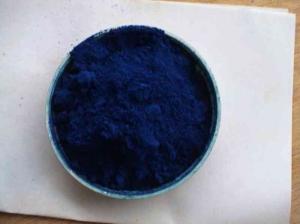Middle chrome yellow 103N
- Loading Port:
- China Main Port
- Payment Terms:
- TT OR LC
- Min Order Qty:
- -
- Supply Capability:
- -
OKorder Service Pledge
OKorder Financial Service
You Might Also Like
Quick Details
Product form: Yellow powder
Category: Yellow pigment PbCrO4
Color reference number : Pigment yellow 34 (77600)
CAS No. : 7758-97-6
Uses : Ink, coating, plastic
Specifications
Color value and tinting strength
| Minimum | Maximum |
Binding material alkyd resin for use in test | ||
Color | Approximate | A little |
△E*ab |
| 1.0 |
Relative tinting strength [%] | 95 | 105 |
Technical data
| Minimum | Maximum |
Water soluble matter [%] |
| 1.0 |
Residue on sieve (0.045mm) [%] |
| 0.3 |
pH value | 6.0 | 9.0 |
Oil absorption [g/100g] |
| 22 |
105℃ volatile matter |
| 1.0 |
Heat resistance (maximum temperature after heating for 5 minutes) [℃] | ~ 240 | |
Light resistance[grade] | ~ 7-8 | |
Weather resistance [grade] | ~ 4 | |
Packing
25kg/bag
Storage and transportation
Keep in dry place.
Opened product
should be tightly sealed to protect from damp and contamination.
- Q: What is the difference between dyes and pigments? Could you give some examples of each one please.
- nan
- Q: what are the accessory pigments in plant photosynthesis?
- This Site Might Help You. RE: what are the accessory pigments in plant photosynthesis?
- Q: like what's the definition relating to sunlight
- Pigments are substances which are used familiarly to create pictures and printings. Pigments give an object a color when in a field of incident white light. Pigments themselves absorb a set of incident colors of light and reflect all others. When multiple pigments are mixed, their ability to absorb colors is added, such that their ability to reflect colors is subtracted.
- Q: I bought the color Frozen White, and the store sample was sort chunky too, and it doesn't go on my skin well because of that. How can I apply it on smoothly? do I need to add a little water??? help!!!!
- Some pigments are just designed to be chunky. As the answer above said, definitely use fix+ or mixing mediums. water will not be good enough as it does not have that 'sticky' residue that both fix+ and mixing mediums have. Also, I find that having an eyeshadow base helps a lot - makes pigments a tad easier to blend. This may work or it may not, really depends on the individual pigment, and i've never used Frozen White before... BUT try breaking up the pigment chunks by using a plastic spatula (should be able to buy them in make up stores like Sephora). Literally, put some on the cap and then just crush it until it becomes finer. Hope this helps :)
- Q: which do you think is better??? and how do you apply pigment??? my boyfriend gave me a bag full of MAC make up in which there are 2 pigment bottles... i already love their eyeshadow.. i just want people's opinion on which one is better and when to use pigment... i mean, what is the difference??? Help Please!
- Pigment is basically a loose eyeshadow. To apply: you just dip your brush in and apply like normal eyeshadow. You can use a wet eyeliner brush to apply in the crease of your eye or under your eye like eyeliner. It's good stuff, I use it often. You can use a lighter application for day- neutral tones and create some dark, dramatic makeup for going out. My personal opinion is I like the eyeshadows better, they seem to last longer when applied dry. The pigment tends to wear off faster when applied dry. I haven't tried wet yet, so that may be better. You're a lucky girl to have a boyfriend who actually buys you makeup.
- Q: Please help me answer these Genetics problems. These are the problems that was assigned in the previous exams, but the professor doesn't provide the answer keys or a review session to go over these.Pigment in the mouse is produced only when the C allele is present. Individuals of the cc genotype have no color. if color is present, it may be determined by the A, a alleles. AA or Aa results in the agouti color, while aa results in the black color. In 3 crosses between agouti females whose genotypes are unknowns and males of the aacc genotype, the following phenotypic ratios were obtained. Female 1: 8 agouti 8 colorlessFemale 2: 4 agouti 5 black 10 colorless
- interior the 1st bypass AACC x aacc, discern a million will produce all AC gametes and discern 2 ac. Your F1 will all be AaCc. As all have the C allele they are going to be pigmented and as they're Aa they're going to all be agouti. Your F1 bypass is AaCc x AaCc. each and each discern can produce 4 gametes AC, Ac, aC, ac. To get all the genotypes you would be able to desire to entice a 4 x 4 Punnett sq.. each and each column and each and each row has between the 4 gametes in it and the cells comprise the blended genotypes. in case you count type up your genotypes you will discover 9 comprise the two A and C, those are agouti, 4 comprise cc, and all of those would be white regardless of the genotype at A, 3 comprise aa and C, those will all be black. So your phenotypic ratio would be 9:4:3 agouti: white: black the subsequent 3 crosses are all attempt crosses - you employ a recessive discern to artwork out the genotype of the different discern. a million. As lots of the offspring are colourless, you be attentive to that the two mothers and dads carry the c allele, as you pick cc for colourless mice. As there are no black mice, there is not any a allele interior the mum, as no aa offspring are produced. The bypass is AACc x aacc. woman gametes are AC or Ac and male gametes are all ac, offspring are the two AaCc or Aacc. 2. Is the opposite of bypass a million. There are black offspring so mom would desire to hold an a allele to furnish black mice, as there are no colourless ones, there is not any c allele interior the mum. you could write down the bypass and the F2 effect now. 3. This time all hues are produced, so the mum would desire to hold the two a and c alleles. Her genotype is AaCc, she would be able to offer 4 gametes as interior the 1st bypass and you will artwork out the resultant genotypes and phenotypes interior the F2.
- Q: pretty self-explanatory...
- Pigments help in making food for the plants they also give color to it.Pigments are of different types which give different color to its leaves or fruits.Like mango is green first and then turns yellow coz green pigment is replaced by yellow pigment. Green pigment in most of the fruits is present only till it requires food and is raw.
- Q: Explain light activation of pigments (absorption of light by pigments)?
- A pigment is a substance that imparts color by absorbing some frequencies of visible light but not others. For instance, there are a lot of substances that absorb ultraviolet light into the visible spectrum, in other words they also absorb plain violet light. Since they absorb violet light but reflect back the rest of light, they appear yellow. Purple pigments, on the other hand, are quite rare because they absorb purple light (which has the highest energy of visible light) and reflect back everything else. When anything absorbs a photon of electromagnetic radiation (light, x-rays, ultraviolet, infrared, microwaves, gamma rays, radio waves), it is activated which means that it takes the energy of the photon and goes to an energy state that is higher by the same amount of energy that was in the photon. At the molecular level, energy is quantized, meaning its restricted to particular states. For instance, vibrational energy corresponds to infrared light: there are only certain ways, called modes, that a molecule can vibrate in, if it can't vibrate in an appropriate mode, it can't absorb the infrared radiation that corresponds to being promoted to that mode. That's why substances can be transparent. At the higher energy state, the substance might be able to participate in chemical reactions that it would not be able to participate in in a lower state. That's usually what is meant by light activation. So a pigment that absorbs visible or UV light might become activated and react with something or react in ways that it wouldn't be able to in the dark.
- Q: (After the fifteenth century)
- Pigment is color in powder form. An example is lamp black; it was first made from the soot of kerosene lamps ground fine. Binder is a substance used to hold pigment together and make it adhere; in the previous example, linseed oil would be the binder for the lamp black pigment. Vehicle is a medium acting as a solvent, carrier, or binder for paint; turpentine or mineral spirits would be a vehicle but so would linseed oil as well to help dilute the paint and help it cover a large area. Hope that helps and thanx.
- Q: I got this question from my A2 Biology but I can't find the answer. Does anybody know?
- primary pigments are the ones the electron involved in photosyn. goes to AFTER hitting the accessory pigs. in order to be sent to the electron transport chain. this is the case with photosystem 2 AND 1, they look like this: kvhs.nbed.nb.ca/gallant/biology/photosystem.jpg the green are accessory, and the blue is where the primary are. hope that helps...im a little rusty since i took AP bio last year.
Send your message to us
Middle chrome yellow 103N
- Loading Port:
- China Main Port
- Payment Terms:
- TT OR LC
- Min Order Qty:
- -
- Supply Capability:
- -
OKorder Service Pledge
OKorder Financial Service
Similar products
Hot products
Hot Searches
Related keywords

